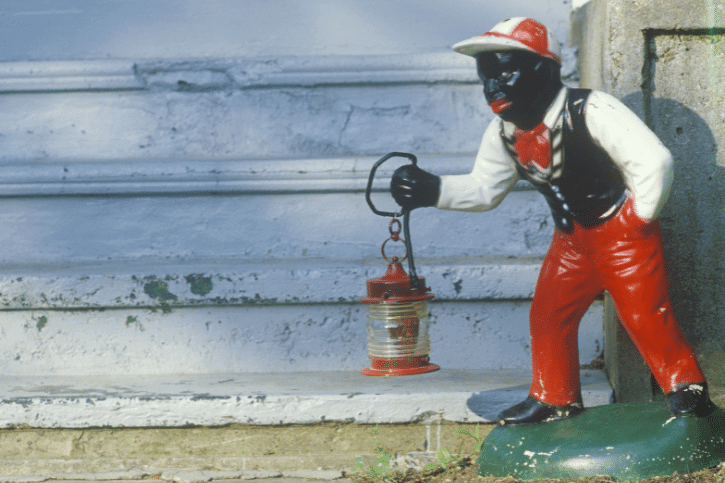What Is A Lawn Jockey?
While I was walking along the street with my son the other day, we passed an odd-looking ornament in a neighbor’s garden, and instantly my son asked me what it was.
I was a bit confused at first and guessed it must be a gnome, since it was a small, ornamental man holding a ring.
Soon I remembered the term lawn jockey and realized I used to see them a lot but never did anymore, so I decided to look into where they came from and what they are.
So, what is a lawn jockey?
A lawn jockey is a small statue of a person in jockey clothes, intended to be placed in front or back yards and used as hitching posts. They have a long and hotly debated history, but today they are really just good lawn decorations for horse racing lovers in the United States, which is where they originate.
It’s a bit of an odd, almost antiquated sight today.
As I said, I remember seeing them much more often in my childhood and for a moment I didn’t even remember what they were.
So, with all that in mind, let’s look at where lawn jockeys come from and how they’re used today.
Where do lawn jockeys come from?
Lawn jockeys are a North American invention, particularly in the United States.
They were originally envisioned as a welcoming symbol to guests and providing somewhere for those on horseback to hitch their horse on the lawn.
They quickly became only decorative and were used less and less as an actual place to hitch a horse.
There is some debate about their actual point of origin.
One legend states that the tradition has its roots with a man named Jocko Graves, a black American who served with George Washington during the American Revolutionary War.
According to the story, Washington left the young boy behind after marching into battle with his army as he thought he was too young to fight.
According to legend, the boy froze to death on the riverbank still holding his lantern outstretched in his arm, as Washington had told him to keep a light on the shore for them.
There is little direct evidence for the truth of this story, unfortunately, and little is really known about the actual origin of the ornament.
Another common idea is that lawn jockeys were used by the Underground Railroad to guide fleeing slaves to freedom.
Again, there is no direct evidence to support this claim, and all that we can really do is speculate.
All we can say for sure is that lawn jockeys emerged in a previous century in order to welcome guests when people would more commonly need a place to hitch their horse.
What do lawn jockeys look like?
Typical lawn jockeys are about a foot or so tall, and wear traditional jockey outfits.
Many of them wear a bright red coat and hat, though other colors are common as well.
Today, lawn jockeys depict both black and white people, usually men.
In the past, lawn jockeys’ depictions were much more problematic.
The earliest kind of lawn jockey, known as a ‘jocko’, typically depicted a cartoonish and racist caricature of a young black boy.
They also had gaudy colors for the racing colors.
Today, these kinds of lawn jockeys are virtually non-existent.
Lawn jockeys also used to have their right arm raised, but today it is typically the left arm that is raised.
This design is known as the cavalier spirit.
Lawn jockeys are usually depicted holding a metal ring, which would be used to hitch a horse.
Are lawn jockeys used everywhere?
Lawn jockeys are really a uniquely American phenomenon.
They are not common anywhere else in the world, certainly not in the past.
In the present day, they have in many ways seeped into the public consciousness since American media dominates so much of what we see and hear today.
Since the world is more connected now, it’s less surprising that they’ve spread, but they are in essence still mostly used in the United States.
The ornament also has a deeply troubled past in many ways, as we’ve explored, since a lot of these depictions were extremely racist or even just kitsch.
Their popularity has wavered a lot over the years and, even though most of them no longer make these racist depictions, they still conjure certain associations in people’s minds.
In the modern day, it would be very uncommon to find a lawn jockey outside the United States.
Indeed, the typical garden gnome is much more popular in Europe today, without the troubling past.
So, lawn jockeys are still quite popular today, although they have a somewhat controversial and debated past.
Today, they are made in a much more palatable and enjoyable way and they are a great decoration for the yard of any horse racing enthusiast.
Nonetheless, their past must be acknowledged to have a full understanding of what they are and where they come from.
